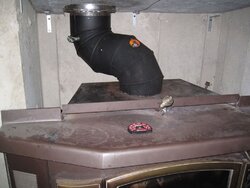Good day to you all,
I own an Earthstove BV400C which was manufactured in 1987. This is a catalytic stove and the cat is 2 seasons old. I've been having an intermittent issue which I'm trying to resolve. First here is my setup...
the stove is in the basement surrounded by concrete (it's inside an area that was built to be a foundation chimney jog.) There is a doublewall pipe that extends from this space, up and out the top of the chimney jog, and is attached along the side of the house. To attach the stove to the double-wall pipe, I used two black singlewall pipe 90 degree adjustable elbows, which fits perfectly between the stove and the bottom of the doublewall pipe (in an S shape). This single-wall pipe sits in a 1" lip inside the top of the stove and everything is screwed together. I have a probe thermometer in the black pipe about 10" up from the top of the stove that normally reads anywhere between 700-1000 when the cat is lit (the cat probe usually reads between 800-1200 at this point).
Here is my problem...every so often, the temp in the stovepipe takes off...it will climb to over 1000 and keep climbing. the other day it was at 1500 and still climbing when I caught it. I opened the bypass and the stove door, which seemed to extinguish the problem and the temp dropped back down to 900. My chimney is clean and that black pipe will gather creosote now and then, but I normally clean out the whole stack monthly during a burn season. I'm trying to figure out why the pipe does this and wondering if it may be due to air leaking in at the joint between the stove and the pipe causing a burn behind the catalytic combustor and inside that pipe.
The strangest part of this is, I've had this stove for 10 years and this only started happening - occasionally - 2 seasons ago. the only change in that time for anything with this setup is the catalytic combustor, but the cat that was in there before this one was the same style, size, manufacturer, etc, and this cat itself appears to be running normally.
Any help would be appreciated and thank-you for your time. Please let me know if more info is needed.
Mike
I own an Earthstove BV400C which was manufactured in 1987. This is a catalytic stove and the cat is 2 seasons old. I've been having an intermittent issue which I'm trying to resolve. First here is my setup...
the stove is in the basement surrounded by concrete (it's inside an area that was built to be a foundation chimney jog.) There is a doublewall pipe that extends from this space, up and out the top of the chimney jog, and is attached along the side of the house. To attach the stove to the double-wall pipe, I used two black singlewall pipe 90 degree adjustable elbows, which fits perfectly between the stove and the bottom of the doublewall pipe (in an S shape). This single-wall pipe sits in a 1" lip inside the top of the stove and everything is screwed together. I have a probe thermometer in the black pipe about 10" up from the top of the stove that normally reads anywhere between 700-1000 when the cat is lit (the cat probe usually reads between 800-1200 at this point).
Here is my problem...every so often, the temp in the stovepipe takes off...it will climb to over 1000 and keep climbing. the other day it was at 1500 and still climbing when I caught it. I opened the bypass and the stove door, which seemed to extinguish the problem and the temp dropped back down to 900. My chimney is clean and that black pipe will gather creosote now and then, but I normally clean out the whole stack monthly during a burn season. I'm trying to figure out why the pipe does this and wondering if it may be due to air leaking in at the joint between the stove and the pipe causing a burn behind the catalytic combustor and inside that pipe.
The strangest part of this is, I've had this stove for 10 years and this only started happening - occasionally - 2 seasons ago. the only change in that time for anything with this setup is the catalytic combustor, but the cat that was in there before this one was the same style, size, manufacturer, etc, and this cat itself appears to be running normally.
Any help would be appreciated and thank-you for your time. Please let me know if more info is needed.
Mike


